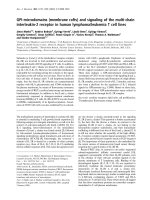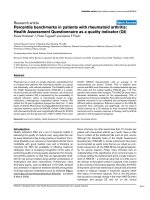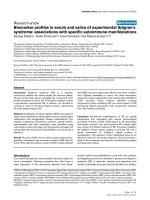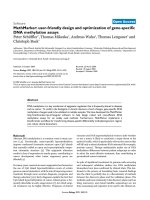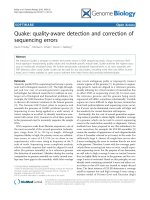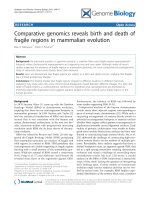Báo cáo y học: "Disentangling manual muscle testing and Applied Kinesiology: critique and reinterpretation of a literature review" pot
Bạn đang xem bản rút gọn của tài liệu. Xem và tải ngay bản đầy đủ của tài liệu tại đây (273.89 KB, 7 trang )
BioMed Central
Page 1 of 7
(page number not for citation purposes)
Chiropractic & Osteopathy
Open Access
Commentary
Disentangling manual muscle testing and Applied Kinesiology:
critique and reinterpretation of a literature review
Mitchell Haas*
1
, Robert Cooperstein
2
and David Peterson
1
Address:
1
Western States Chiropractic College, 2900 NE 132nd Avenue, Portland, OR 97230, USA and
2
Palmer College of Chiropractic West, San
Jose, CA 95134, USA
Email: Mitchell Haas* - ; Robert Cooperstein - ; David Peterson -
* Corresponding author
Abstract
Cuthbert and Goodheart recently published a narrative review on the reliability and validity of
manual muscle testing (MMT) in the Journal. The authors should be recognized for their effort to
synthesize this vast body of literature. However, the review contains critical errors in the search
methods, inclusion criteria, quality assessment, validity definitions, study interpretation, literature
synthesis, generalizability of study findings, and conclusion formulation that merit a reconsideration
of the authors' findings. Most importantly, a misunderstanding of the review could easily arise
because the authors did not distinguish the general use of muscle strength testing from the specific
applications that distinguish the Applied Kinesiology (AK) chiropractic technique. The article makes
the fundamental error of implying that the reliability and validity of manual muscle testing lends
some degree of credibility to the unique diagnostic procedures of AK. The purpose of this
commentary is to provide a critical appraisal of the review, suggest conclusions consistent with the
literature both reviewed and omitted, and extricate conclusions that can be made about AK in
particular from those that can be made about MMT. When AK is disentangled from standard
orthopedic muscle testing, the few studies evaluating unique AK procedures either refute or
cannot support the validity of AK procedures as diagnostic tests. The evidence to date does not
support the use of MMT for the diagnosis of organic disease or pre/subclinical conditions.
Background
Cuthbert and Goodheart recently published a narrative
review on the reliability and validity of manual muscle
testing (MMT) in the Journal [1]. They concluded that
"The MMT employed by chiropractors, physical thera-
pists, and neurologists was shown to be a clinically useful
tool, but its ultimate scientific validation and application
requires testing that employs sophisticated research mod-
els in the areas of neurophysiology, biomechanics, RCTs,
and statistical analysis." The authors included Applied
Kinesiology (AK) applications under the rubric of MMT.
The authors should be recognized for their effort to syn-
thesize this vast body of literature. However, the review
contains critical errors in the search methods, inclusion
criteria, quality assessment, validity definitions, study
interpretation, literature synthesis, generalizability of
study findings, and conclusion formulation that merit a
reconsideration of the authors' findings. Most impor-
tantly, a misunderstanding of the review could easily
arise, because the authors did not distinguish the general
use of manual muscle strength testing from the specific
applications that distinguish the AK chiropractic tech-
nique. The purpose of this commentary is to provide a
Published: 23 August 2007
Chiropractic & Osteopathy 2007, 15:11 doi:10.1186/1746-1340-15-11
Received: 23 April 2007
Accepted: 23 August 2007
This article is available from: />© 2007 Haas et al; licensee BioMed Central Ltd.
This is an Open Access article distributed under the terms of the Creative Commons Attribution License ( />),
which permits unrestricted use, distribution, and reproduction in any medium, provided the original work is properly cited.
Chiropractic & Osteopathy 2007, 15:11 />Page 2 of 7
(page number not for citation purposes)
critical appraisal of the review to expose important flaws,
suggest conclusions consistent with the literature
reviewed and omitted, and disentangle conclusions that
can be made about AK in particular from those that can be
made about MMT. Note that we have not conducted a full
systematic review.
Discussion
Appraisal elements
The validity of this review of MMT inevitably depends on
the quality of the review process. It does not appear to
have been the intent of the authors to conduct a full sys-
tematic review of the literature, and we do not hold them
to that standard. However, design elements of a good sys-
tematic review of diagnostic tests [2-4], as well as critical
appraisal of the measurement evaluation literature [5-14],
are pertinent to the discussion at hand. Even the more tra-
ditional narrative review shares many of these elements
[15]. We have compiled questions that must be consid-
ered in order to draw valid inference on the usefulness of
AK diagnostic procedures (Table 1); these questions are
based on research and synthesis methodology from the
citations above. The answers to these few questions pose
a serious challenge to the authors' conclusion about the
usefulness of AK.
AK entanglement
AK has a long and rich history in chiropractic [1,16]. Many
chiropractors report use of the technique in some form
[17,18]. Clearly, AK is viewed by its proponents as more
than standard orthopedic/neurological muscle testing.
MMT, as performed by chiropractors, does not necessarily
differ in its execution and interpretation from manual
muscle testing as performed and interpreted by the stand-
ards applied in physical medicine. To either practitioner,
a weak muscle might suggest a primary muscular or neu-
rological pathology. However, AK technique uses manual
muscle testing not just to evaluate the functional integrity
of muscle and nerve supply, but also as a means to "diag-
nose structural [and functional], chemical, and mental
dysfunctions [1]." Some of its distinguishing diagnostic
procedures include the use of provocative tests (i.e., AK
challenge and therapy localization) in conjunction with
MMT to identify the need for treatment of neuromuscu-
loskeletal, organic, and metabolic conditions [19-21].
Muscle weakness is also considered diagnostic of pre/sub-
clinical organic, non-neuromusculoskeletal disease.
MMT is a standard component of the neuromusculoskel-
etal physical examination [22]. We agree with the authors
that MMT is useful in the assessment of weakness of mus-
cles directly involved with pain, injury, and neuromuscu-
loskeletal disorders. However, extrapolation of MMT
properties to unique AK applications is risky for several
reasons. MMT reliability/validity for specific neuromuscu-
loskeletal conditions may not be generalizable to other
applications such as identification of organic disorders.
MMT may be reliable/accurate for muscle strength assess-
ment in isolation, but not when used in conjunction with
a spinal challenge (force applied to a vertebral articula-
tion) or other provocative test used for specific AK diagno-
sis. The authors also confuse two uses of the term validity:
test accuracy and diagnostic validity. A test may be
extremely accurate, let us say for example dynamometric
evaluation of muscle force in newtons, but still have no
sensitivity or specificity for the diagnosis of a specific con-
dition [5,6]. Cuthbert and Goodheart conflated evidence
for AK with evidence of the reliability/validity of standard
orthopedic MMT. The reliability and accuracy of MMT
does not establish the usefulness of MMT for its unique
AK applications.
Search strategy and inclusion criteria
The review by Cuthbert and Goodheart illustrates how
failure to utilize a fastidious search strategy can miss criti-
cal citations and impact review findings. The authors con-
ducted an online search of PubMed and CINAHL, using
the search terms "manual muscle test" and "manual mus-
Table 1: Critical appraisal questions for Applied Kinesiology (AK)
Literature review
1. Were clear clinical questions identified and answered?
2. Were clear and appropriate inclusion/exclusion criteria identified and followed?
3. Was a thorough literature search conducted that retrieved all the pertinent literature?
4. Was an appropriate literature synthesis method identified and properly applied?
5. Was the literature interpreted properly?
6. Were the authors conclusions correct?
Measurement evaluation (test usefulness)
1. Was the reliability of AK diagnostic procedures determined to be adequate?
2. Was the construct validity of AK procedures identified?
3. Was the sensitivity and specificity or likelihood ratios of AK diagnostics for the identification of clinical procedures shown to be adequate?
4. Was the clinical utility of AK diagnostic procedures evaluated?
5. Was the efficacy of AK diagnostic procedures determined?
Chiropractic & Osteopathy 2007, 15:11 />Page 3 of 7
(page number not for citation purposes)
cle testing." No further details were provided, so the
search cannot be duplicated exactly. There are several
problems pertaining to the scope of the search that may
have led to the omission of relevant articles. In our search
of PubMed, the addition of the search term "muscle test-
ing" increased the number of papers found from 639 to
13,802. We also conducted a search using MEDLINE and
CINAHL. Including the additional term "muscle testing"
increased the number of hits from 454 to 709, and the
number of papers specifically pertaining to reliability/
validity from 97 to 136. The second problem is that Cuth-
bert and Goodheart failed to search the chiropractic data-
base, MANTIS. Including a search of this database
increased the number of muscle testing papers from 709
to 1297 and the reliability/validity-related papers from
136 to 221. We also conducted a search using the Boolean
strategy: Applied Kinesiology AND (reliability OR valid-
ity). The inclusion of MANTIS increased our yield from 15
to 32 articles. The authors may also have failed to use
another important search strategy, namely checking arti-
cle references to identify further pertinent studies.
The authors stated that they selected studies based on rel-
evance, but did not include an operational definition. It
appears that any MMT article on a pain-related disorder
was considered relevant. It is not clear how "reliability/
validity" and "MMT" were used in the selection process.
Negative studies were certainly omitted. Had the authors
used the search term "muscle testing" and included the
MANTIS database, they would not have failed to identify
randomized trials designed specifically to evaluate the
contribution of an AK-challenge procedure to MMT
results [23-25]. In any event, the authors should have
been aware of the 1982 study by Triano that was con-
ducted with the assistance of the International College of
Applied Kinesiology [23] and critiqued by Goodheart in a
letter to the editor [26].
One selection criterion introduced clear and significant
bias into the review. Studies were only included if a kappa
≥ 0.5 was reported for the assessment of reliability or
validity (though kappa is not generally a validity index).
Clearly this inclusion criterion was not uniformly applied,
since many of the included studies did not address relia-
bility and thus did not report a kappa value. More impor-
tantly, the use of this criterion was based on a
misunderstanding of Swinkles et al [27]. These authors
used the criterion for setting standards for determining
whether certain instruments had good construct validity;
they did not use a threshold of kappa ≥ 0.5 to identify eli-
gibility for their systematic review. The result of using this
kappa selection criterion by Cuthbert and Goodheart was
the exclusion of all but the studies with moderate to excel-
lent reliability/validity. The biased inclusion criterion
clearly set up a tautology that pre-determined a positive
conclusion about the usefulness of MMT.
Quality evaluation and evidence synthesis
Evaluation of study quality is an important aspect of liter-
ature reviews [15,28], and certainly there are many meth-
ods for doing this [29]. Cuthbert and Goodheart write in
the methods section that a quality assessment was per-
formed. It is not until the end of the paper that the authors
acknowledge that internal and external validity have not
been critically evaluated. The authors had no formal crite-
ria or algorithm for synthesizing the literature to reach a
conclusion about MMT in general and AK specifically.
Without quality assessment, studies of great merit are
inevitably given no more weight than studies with serious
design flaws and unsupported conclusions. In particular,
it is not advisable to take authors' conclusions from
included articles at face value. Misinterpretations occur.
Some examples in the chiropractic literature of conclu-
sions inconsistent with study design and results are iden-
tified in several reviews [9,30,31].
Evidence from treatment investigations
Cuthbert and Goodheart attempt to infer clinical rele-
vance for MMT diagnosis from studies with positive treat-
ment outcomes. One example cited by the authors in their
Table 4 is an observational study by Moncayo et al [32].
The implied logic is that if an AK procedure is used to
identify the need for treatment and patients have positive
outcomes, then there is evidence that the AK procedure is
a valuable diagnostic tool. The flaw in this line of reason-
ing is that patients can improve despite the diagnostic pro-
cedures used. This has actually been demonstrated in a
randomized trial evaluating the efficacy of a commonly
used chiropractic diagnostic procedure [33]. An effica-
cious treatment (e.g. spinal manipulation) does not
require a valid or efficacious diagnostic test as a treatment
indicator [7,33].
Evidence from randomized trials
The authors note several times in the text that MMT has
been investigated in randomized trials. This assertion
requires some clarification. In all the randomized trials
cited, patients were randomized to treatment or treatment
control, and not to diagnostic test or diagnostic test con-
trol. This means that the efficacy of treatment was under
investigation, rather than the efficacy of the MMT. How-
ever, the authors inflated the importance of MMT reliabil-
ity and validity evaluation by invoking the prestige of the
randomized trial; non-randomized cross-sectional/longi-
tudinal studies carry the same weight for the evaluation of
diagnostic and prognostic tests.
The efficacy (contribution to patient outcomes) of diag-
nostic tests and manipulation indicators can and should
Chiropractic & Osteopathy 2007, 15:11 />Page 4 of 7
(page number not for citation purposes)
be evaluated in blinded randomized trials [7,33,34]. We
thus agree with the authors' statement that more rand-
omized trials are necessary to validate AK applications of
MMT. However, randomized trials of treatment efficacy
will not validate AK diagnostics as the authors contend.
Blinded randomized trials can be used not only to evalu-
ate test efficacy, but also to investigate construct validity
and the contribution of provocative tests (e.g., joint chal-
lenge) to MMT findings. Several construct validity trials of
tests used in AK are discussed under construct validity
below [23,24].
Reliability
Reliability is usually considered a necessary but insuffi-
cient condition for establishing the usefulness of a diag-
nostic test [5,6]. That is, poor reliability generally rules out
the usefulness of a test (at least in the context of how it is
measured [25]), but good reliability does not ensure use-
fulness. As mentioned above, we do not dispute the relia-
bility of orthopedic/neurological MMT, and are only
interested in the reliability of distinctively AK applications
of MMT. Several such double-blind studies were omitted
from the review [25,35-37].
Jacobs showed good reliability in an unblinded test of
sugar solutions but only fair reliability in a double-blind
test of MMT response to orally administered oil solutions
[35]. Haas et al found poor interexaminer reliability of
MMT of a vertebral challenge (muscle "strength" change
following directional pressure on the vertebral spinous
process) [25]. Two small double-blind studies looked at
MMT response to bottled substances held in the patient's
hand. Ludtke et al found that response was no better than
guessing for both wasp venom and inert substance [36],
Garrow showed no test-retest reproducibility of MMT for
identifying potential allergens [37]. Pothmann et al.
found good intraexaminer, but poor interexaminer
(kappa = 0) reliability for muscle tests used for identifying
food intolerance in children [38]. Note that we only
viewed the English abstract translated from German.
Other reliability studies not included in the review are
described below. These were either poorly designed or
had negative results.
Peterson found poor reliability in a study of emotional
arousal; reliability improved dramatically when con-
founding variables were taken into consideration [39].
However, this study was poorly designed in that negative
confounders were identified and eliminated post hoc
using semi-structured interviews, whereas positive con-
founders were not sought. In Kenney et al, 11 subjects
were examined by 3 trained muscle testers for the need of
supplementation with 4 different nutrients (zinc, vitamin
C, thiamin, and vitamin A) [40]. The examiners did not
agree with one another, nor did any of their individual
results correlate with laboratory testing, nor was there any
correlation of manual and mechanical measures of mus-
cle strength (poor reliability and validity).
Rybeck and Swenson found manual muscle testing (with
the Latissimus dorsi), but not mechanical muscle testing,
able to discriminate between sugar and no sugar being
placed under the tongue [41]. It should be noted that the
subjects were not blinded. Although Friedman and Weis-
berg attempted to test certain AK procedures, their study
simply listed the data and lacked any statistical analysis,
making it difficult to interpret [42].
Construct validity
Leboeuf et al investigated the so-called arm-fossa test, a
manual muscle testing method used in Sacro-Occipital
Technique (SOT) [43]. They evaluated the SOT construct
that the arm-fossa test (AK-style muscle test with associ-
ated challenge test) is responsive to proper prescribed
blocking treatment but unresponsive (unchanged) fol-
lowing improper or no treatment (N = 45). The test
returned to normal on follow-up in 73%, 37.5%, and
14% of participants respectively. Results were mixed in
this assessor-blind study. In support of the construct,
properly treated subjects were more likely to have a nor-
mal follow-up than untreated subjects. Contrary to pre-
diction, post hoc testing showed no difference between
properly and improperly treated groups, or between
improperly and untreated groups (P > .025). Only the
properly treated group demonstrated follow-up test
results different from mere guessing. It should be pointed
out that the evidence is not strong, because of the small
sample size and the unblinded subjects.
Important negative evidence was not included in the
review: the work of Jacobs et al, Triano, and Haas et al
[23,24,35]. Jacobs found that MMT responses to oral solu-
tions were not consistent with AK theoretical expectations
in a double-blind experiment [35].
Triano conducted two double-blind experiments (using
crossover randomized trial design) to evaluate the AK con-
struct that a weak Latissimus dorsi is associated with the
need for pancreatic nutritional supplementation [23].
More specifically, the two theoretical constructs investi-
gated were that a sublingual or cutaneous challenge with
pancreatic tissue extract can restore the latissimus dorsi
MMT to normal. The control challenges were cardiac,
thymic, and testicular extracts that were identified by AK
practitioners as unlikely to affect the MMT. There were no
differences in post-challenge positive test rates between
extracts, indicating no relationship of pancreatic-extract
challenge to Latissimus dorsi strength. Triano suggested
Chiropractic & Osteopathy 2007, 15:11 />Page 5 of 7
(page number not for citation purposes)
that future clinical AK research should be informed by
constructs developed from basic science studies of AK
mechanisms.
Haas et al conducted a double-blind randomized trial, on
a mix of participants with and without back pain, to eval-
uate the relationship of MMT response to a provocative
vertebral challenge and to spinal manipulation [24]. They
investigated the AK construct that MMT with spinal chal-
lenge can be used to monitor response to spinal manipu-
lation. The first phase of the study was a crossover design
to compare MMT response of the piriformis to a vertebral
challenge and a sham challenge. The second phase of the
study was a parallel-groups design to compare MMT
response to vertebral challenge in participants either
receiving manipulation or receiving no manipulation of
the spine. Interestingly, the positive test rates were consist-
ent before treatment across vertebral segments (mean =
5.6%), and post intervention for both treatment and con-
trol groups after manipulation at vertebral levels with pre-
test positive and with pretest negative MMT (8% to 10%).
The authors concluded, "For the population under study,
muscle response appeared to be a random phenomenon
unrelated to manipulable subluxation. In and of itself,
muscle testing appears to be of questionable use for spinal
screening and post-adjustive evaluation [24]."
There is a recurring theme in these trials. Blinded MMT
demonstrates uniform positive test rates, regardless of the
presence/absence of or type of the provocative test (e.g.,
spinal challenge). We can hypothesize that there may be
an inherent positive test rate associated with particular
muscles. Perhaps this rate is dependent on the patient's
state of health. Interestingly, since these positive test rates
are fairly small, any follow-up tests, with or without pro-
vocative test, have a high probability of being negative.
Therefore, clinicians will inevitably think they have suc-
cessfully treated a condition identified by the original test,
despite the fact that the follow-up test results may be inde-
pendent of intervention. That is, the clinician could be
fooled by a statistically random phenomenon associated
with a worthless test, a test with results unrelated to pro-
vocative procedure and insensitive to spinal manipula-
tion.
Criterion validity
Cuthbert and Goodheart did not establish the criterion
validity for any MMT putatively associated with a condi-
tion (neuromusculoskeletal or otherwise) unrelated to a
neuromusculoskeletal condition of the same muscle.
Thus, they did not present evidence for the criterion valid-
ity for any AK challenge or therapy localization test.
The authors do cite a study of a therapy localization test
by Pollard et al, which utilized the patient's hand contact
on the "ileocecal valve point" in conjunction with a del-
toid MMT to identify patients with low back pain (gold
standard) [44]. The study showed high sensitivity and spe-
cificity of the test. However, the unique effects associated
with therapy localization and with MMT of different pop-
ulations using the deltoid muscle were confounded and
the effects of neither component were evaluated. For
example, the observed validity could have been due to dif-
fering base positive test rates in persons with and without
low back pain, and nothing to do with the therapy locali-
zation test. The differing positive test rate could be trivially
related to distraction or discomfort from the back pain
itself, so that the same results could have been obtained
from any muscle. Participants were not guaranteed to be
naïve with regards to the purpose of the study. These
issues could be sorted out using randomized trials as
described above. Finally, the high sensitivity and specifi-
city in this particular study are not clinically compelling
for two reasons. It does not indicate any specific treat-
ment, and there is a perfectly accurate, cost-effective, and
easily performed test available: patient report of low back
pain.
The authors did include an early study by Jacobs et al that
looked at the correlation of an AK test battery for thyroid
function with independent evaluation using clinical signs
and symptoms and laboratory tests [45]. Patients were
rated on a 7-point scale from unquestionable hypothy-
roidism to unquestionable hyperthyroidism. The protocol
for determining the scale ratings from the battery of test
results was not described. The correlation between the AK
regimen and other test batteries was r = 0.32 to 0.36, indi-
cating modest accuracy. The results could also be
explained by the lack of definitive gold standard or, per-
haps, the un-standardized methods of test interpretation.
Missing was Pothmann et al, who found no significant
relationship of AK MMT with laboratory tests for identify-
ing nutritional intolerance in children: RAST (radioaller-
gosorbent test) and Cytolisa (sensitivity 73.6%, specificity
45.2%) and lactose breath hydrogen test (sensitivity
77.1%, specificity 43.2%) [38]. The poor positive likeli-
hood ratios (1.34 and 1.36) and poor interexaminer reli-
ability suggest the test performs no better than guessing.
Reviews and critiques
The authors did not acknowledge previous reviews and
critiques of AK. Teuber and Porch-Curren note that several
studies refute AK in diagnosis of food allergies and they
concluded: "The weight of the evidence to date suggests
that this diagnostic modality is not validated when sub-
jected to scrutiny [46]." Tschernitschek and Fink reviewed
AK procedures including those used in dentistry. They
concluded that there is a lack of evidence for AK effective-
ness, reliability, and validity [47]. Haas found that MMT
Chiropractic & Osteopathy 2007, 15:11 />Page 6 of 7
(page number not for citation purposes)
reliability could not be substantiated before 1991 because
of methodological and statistical limitations of published
studies [9]. Klinkoski and LeBoeuf reviewed scientific
papers published by the International College of Applied
Kinesiology between 1981 and 1987 [48]. The authors
concluded that no conclusions could be drawn because of
inadequate methodological quality based on clear identi-
fication of sample size, inclusion criteria, blind and naive
subjects, reliable test methods, blind assessors, and statis-
tical analysis. Motyka and Yanuck found that the body of
AK research is equivocal, sometimes confirmatory of reli-
ability and validity, other times not confirmatory, and
often simply irrelevant due to various design flaws [49].
Diagnosis of preclinical and subclinical disease
AK proponents claim to be able to diagnose preclinical
and subclinical conditions [1,16]. Demonstration of the
validity of MMT for such conditions would require a com-
parison to a standard with strong predictive validity of dis-
ease, or demonstration that prophylactic care based on AK
MMT results prevents or diminishes the development of
disease relative to an untreated control group. We could
find no such studies.
Conclusion
Cuthbert and Goodheart conducted a review with impor-
tant methodological deficiencies. When manual muscle
testing as used in Applied Kinesiology is disentangled
from standard orthopedic/neurological muscle testing,
the few studies evaluating specific AK procedures either
refute or cannot support the validity of AK procedures as
diagnostic tests. In particular, the use of MMT for the diag-
nosis of organic disease or putative pre/subclinical condi-
tions is insupportable.
Competing interests
The author(s) declare that they have no competing inter-
ests.
Authors' contributions
All authors critically appraised the Cuthbert and Good-
heart review. Haas wrote the initial draft. Cooperstein and
Peterson added material to subsequent drafts. All authors
reviewed and approved the final submission.
References
1. Cuthbert SC, Goodheart GJ Jr.: On the reliability and validity of
manual muscle testing: a literature review. Chiropr Osteopat
2007, 15:4.
2. Cochrane Methods Group: The Cochrane Methods Group on
systematic review of screening and diagnostic tests: recom-
mended methods. Cochrane 1996, 6-6: [ />cochrane/cochrane/sadtdoc1.htm].
3. Shapiro DE: Issues in combining independent estimates of the
sensitivity and specificity of a diagnostic test. Acad Radiol 1995,
2:S37-S47.
4. Irwig L, Macaskill P, Glasziou P, Fahey M: Meta-analytic methods
for diagnostic test accuracy. J Clin Epidemiol 1995, 48:119-130.
5. Sackett DL: A primer on the precision and accuracy of the clin-
ical examination. JAMA 1992, 267:2638-2644.
6. Haas M, Taylor JAM, Gillette RG: The routine use of radiographic
spinal displacement analysis: a dissent. J Manipulative Physiol
Ther 1999, 22:254-259.
7. Sackett DL, Haynes RB, Guyatt GH, Tugwell P: Clinical epidemiology. A
basic science for clinical medicine. 2nd edition. Boston, Little Brown and
Company; 1991.
8. Bossuyt PM, Reitsma JB, Bruns DE, Gatsonis CA, Glasziou PP, Irwig
LM, Lijmer JG, Moher D, Rennie D, de Vet HC: Towards complete
and accurate reporting of studies of diagnostic accuracy: the
STARD initiative. BMJ 2003, 326:41-44.
9. Haas M: The reliability of reliability. J Manipulative Physiol Ther
1991, 14:199-208.
10. Guyatt GH, Tugwell PX, Feeny DH, Haynes RB, Drummond M: A
framework for clinical evaluation of diagnostic technologies.
Can Med Assoc J 1986, 134:587-594.
11. Jaeschke R, Guyatt G, Sackett DL: Users' guides to the medical
literature. III. How to use an article about a diagnostic test.
A. Are the results of the study valid? JAMA 1994, 271:389-391.
12. Jaeschke R, Guyatt GH, Sackett DL: Users' guides to the medical
literature. III. How to use an article about a diagnostic test.
B. What are the results and will they help me in caring for
my patients? JAMA 1994, 271:703-707.
13. Laupacis A, Wells G, Richardson WS, Tugwell P: Users' guides to
the medical literature. V. How to use an article about prog-
nosis. JAMA 1994, 272:234-237.
14. Barratt A, Irwig L, Glasziou P, Cumming RG, Raffle A, Hicks N, Gray
JAM, Guyatt GH: Users' guides to the medical literature XVII.
How to use guidelines and recommendations about screen-
ing. JAMA 1999, 281:2029-2034.
15. Feise RJ, Cooperstein R: From narrative to systematic reviews.
J Amer Chiro Assoc 2006, 43:7-9.
16. Gin RH, Green BN: George Goodheart, Jr., D.C., and a history
of applied kinesiology. J Manipulative Physiol Ther 1997,
20:331-337.
17. Christensen MG, Kerkhoff D, Kollasch MW, Cohn L: Job analysis of
chiropractic, 2000: a project report, survey analysis and summary of the
practice of chiropractic within the United States Greeley, CO, National
Board of Chiropractic Examiners; 2000.
18. Christensen MG, Kollasch MW: Job analysis of chiropractic, 2005: a
project report, survey analysis and summary of the practice of chiropractic
within the United States Greeley, CO, National Board of Chiropractic
Examiners; 2005:1-208.
19. Walther DS: Applied Kinesiology. Volume 1: basic procedures and muscle
testing Volume 1. 2nd edition. Pueblo, CO, Systems DC; 1981.
20. Walther DS: Applied Kinesiology: Synopsis Volume 1. 2nd edition. Pue-
blo, CO, Systems DC; 2000.
21. Frost R: Applied Kinesiology: a training manual and reference book of basic
principles and practices Berkeley, CA, North Atlantic Books; 2002.
22. Magee DJ: Orthopedic physical assessment Philadelphia, W.B. Saunders;
1987.
23. Triano JJ: Muscle strength testing as a diagnostic screen for
supplemental nutrition therapy: a blind study. J Manipulative
Physiol Ther 1982, 5:179-182.
24. Haas M, Peterson D, Hoyer D, Ross G: Muscle testing response
to provocative vertebral challenge and spinal manipulation:
a randomized controlled trial of construct validity. J Manipu-
lative Physiol Ther 1994, 17:141-148.
25. Haas M, Peterson D, Hoyer D, Ross G: The reliability of muscle
testing response to a provocative vertebral challenge. Chiro
Tech 1993, 5:95-100.
26. Goodheart GJ Jr.: Muscle strength testing as a diagnostic
screen for supplemental nutrition therapy: a blind study
[Letter]. J Manipulative Physiol Ther 1983, 6:87.
27. Swinkels RA, Bouter LM, Oostendorp RA, Swinkels-Meewisse IJ, Dijk-
stra PU, de Vet HC: Construct validity of instruments measur-
ing impairments in body structures and function in
rheumatic disorders: which constructs are selected for vali-
dation? A systematic review. Clin Exp Rheumatol 2006, 24:93-102.
28. Khan KS, Daya S, Jadad AR: The importance of quality of pri-
mary studies in producing unbiased systematic reviews. Arch
Intern Med 1996, 156:661-666.
29. Moja LP, Telaro E, D'Amico R, Moschetti I, Coe L, Liberati A, on
behalf of the Metaquality Study Group: Assessment of methodo-
logical quality of primary studies by systematic reviews:
Publish with BioMed Central and every
scientist can read your work free of charge
"BioMed Central will be the most significant development for
disseminating the results of biomedical researc h in our lifetime."
Sir Paul Nurse, Cancer Research UK
Your research papers will be:
available free of charge to the entire biomedical community
peer reviewed and published immediately upon acceptance
cited in PubMed and archived on PubMed Central
yours — you keep the copyright
Submit your manuscript here:
/>BioMedcentral
Chiropractic & Osteopathy 2007, 15:11 />Page 7 of 7
(page number not for citation purposes)
results of the metaquality cross sectional study. BMJ 2005,
330:1053.
30. Bronfort G, Assendelft WJJ, Evans RL, Haas M, Bouter LM: Efficacy
of spinal manipulation for chronic headache: a systematic
review. J Manipulative Physiol Ther 2001, 24:457-466.
31. Bronfort G, Haas M, Evans RL, Bouter LM: Efficacy of spinal
manipulative therapy for low back and neck pain: a system-
atic review and best evidence synthesis. Spine J 2004,
4:335-356.
32. Moncayo R, Moncayo H, Ulmer H, Kainz H: New diagnostic and
therapeutic approach to thyroid-associated orbitopathy
based on applied kinesiology and homeopathic therapy. J
Altern Complement Med 2004, 10:643-650.
33. Haas M, Groupp E, Panzer D, Partna L, Lumsden D, Aickin M: Effi-
cacy of cervical endplay assessment as an indicator for spinal
manipulation. Spine 2003, 28:1091-1096.
34. Haas M, Bronfort G, Evans RL: Chiropractic clinical research:
progress and recommendations. J Manipulative Physiol Ther 2006,
29:695-706.
35. Jacobs GE: Applied kinesiology: an experimental evaluation by
double blind methodology. J Manipulative Physiol Ther 1981,
4:141-145.
36. Ludtke R, Kunz B, Seeber N, Ring J: Test-retest-reliability and
validity of the Kinesiology muscle test. Complement Ther Med
2001, 9:141-145.
37. Garrow JS: Kinesiology and food allergy. Br Med J (Clin Res Ed)
1988, 296:1573-1574.
38. Pothmann R, von FS, Hoicke C, Weingarten H, Ludtke R: Evaluation
of applied kinesiology in nutritional intolerance of childhood.
Forsch Komplementarmed Klass Naturheilkd 2001, 8:336-344.
39. Peterson KB: A preliminary inquiry into manual muscle test-
ing response in phobic and control subjects exposed to
threatening stimuli. J Manipulative Physiol Ther 1996, 19:310-316.
40. Kenney JJ, Clemens R, Forsythe KD: Applied kinesiology unrelia-
ble for assessing nutrient status. J Am Diet Assoc 1988,
88:698-704.
41. Rybeck CH, Swenson R: The effects of oral administration of
refined sugar on muscle strength. J Manipulative Physiol Ther
1980, 3:155-161.
42. Friedman MH, Weisberg J: Applied kinesiology double-blind
pilot study. J Prosthet Dent 1981, 45:321-323.
43. Leboeuf C, Jenkins DJ, Smyth RA: Sacro-occipital technique: the
so-called arm-fossa test. Intra-examiner agreement and
post-treatment changes. J Aust Chiro Assoc 1988, 18:67-68.
44. Pollard HP, Bablis P, Bonello R: Can the ileocecal valve point pre-
dict low back pain using manual muscle testing? Chiropr Aust
2006, 36:58-62.
45. Jacobs GE, Franks TL, Gilman PG: Diagnosis of thyroid dysfunc-
tion: applied kinesiology compared to clinical observations
and laboratory tests. J Manipulative Physiol Ther 1984, 7:99-104.
46. Teuber SS, Porch-Curren C: Unproved diagnostic and therapeu-
tic approaches to food allergy and intolerance. Curr Opin
Allergy Clin Immunol 2003, 3:217-221.
47. Tschernitschek H, Fink M: "Applied kinesiology" in medicine
and dentistry a critical review. Wien Med Wochenschr 2005,
155:59-64.
48. Klinkoski B, Leboeuf C: A review of the research papers pub-
lished by the international college of applied kinesiology
from 1981 to 1987. J Manipulative Physiol Ther 1990, 13:190-194.
49. Motyka TM, Yanuck SF: Expanding the neurological examina-
tion using functional neurologic assessment part I: method-
ological considerations. Int J Neurosci 1999, 97:61-76.


